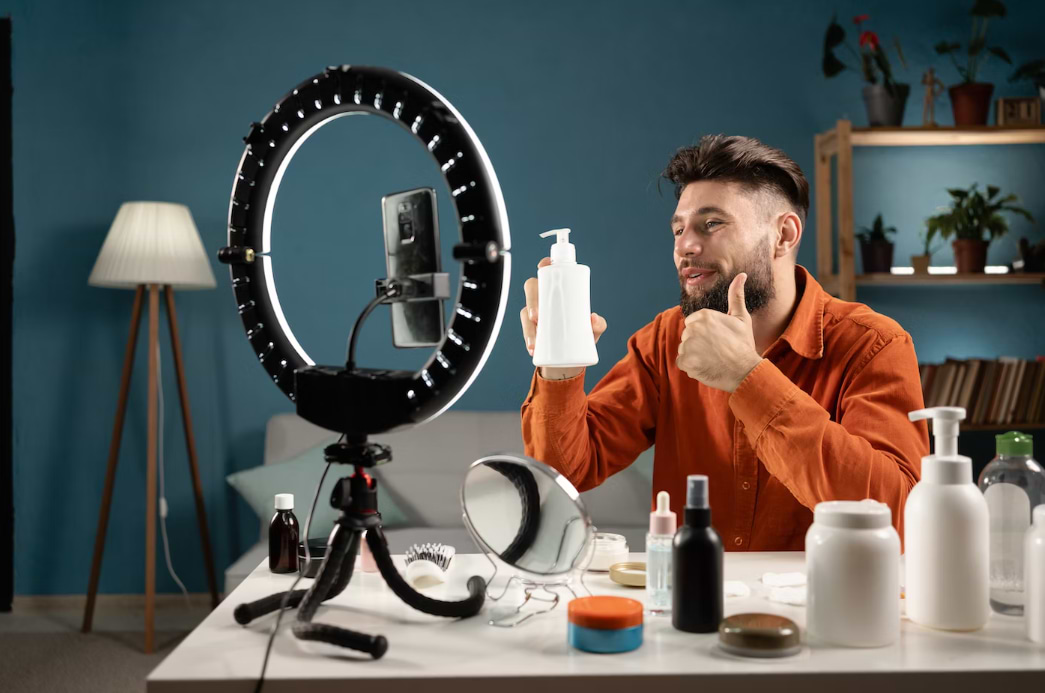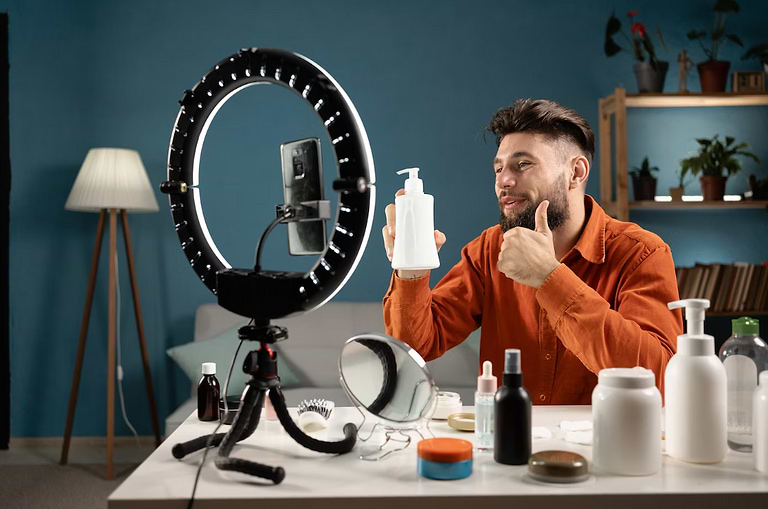Beyond the Runway: Fashion Week’s Untapped Potential with Live Shopping



18/03/2024
Livestream shopping
The Instagram era of fashion weeks where brands showcase to buyers, influencers and celebrities is diminishing.
Having partaken in fashion week since being a teenager, there has been a marked shift in how these things unfold. Historically, fashion weeks were showcased mostly to buyers who could carry the brands in their department storefronts, or celebrities who could plan to include them in future red carpets.
But with the competitive and fast nature of brands like Zara and H&M creating affordable variations of the same, runway brands have been forced to create ready-to-wear outfits and market them quickly. Catapulted on top of this is the advent of social media, and platforms like TikTok have changed consumer habits, emphasizing authenticity and relatability over curated visuals.

And so now, what I see is more phones and cameras at shows than actual people, and the actual buyers and fashion elite scurry away quickly from the actual show, while influencers and creators continue to showcase a slightly warped perspective on their constantly on phones. It isn’t a bad shift, I just think it’s more obvious that commerce and sale-ability is more front and center, versus the historical magic of showcasing craftsmanship and putting on a fashion spectacle.
Given a shift in trying to keep up with the times and drive more commerce, runway brands employ tactics similar to retail brands. And what ties fashion to live shopping?
According to McKinsey, clothing is unanimously the most shopped category in livestreams worldwide (43% in the US, seconded by skincare at 32% which is a huge drop). Which is why, live shopping is a huge opportunity for runway brands to utilize during fashion week.

How fashion embraces VR, AR and Live Shopping
Augmented reality (AR) is becoming integral in luxury fashion, engaging global audiences and evolving rapidly.
According to Vogue Business at London Fashion Week (LFW), AR benefits include enhanced online shopping experiences, improved conversions, and reduced return rates. Brands are bridging practicality and creativity, with a trend toward adding AR layers to their apps and websites.
The global reach of AR allows brands to connect with diverse audiences, creating unique and special experiences, tying ecommerce to runway shows.
Fashion designer Edward Crutchley shared his AR experience, emphasizing the ability to push beyond reality’s boundaries. Snapchat’s evolving technology, such as ray tracing, offers new opportunities for brands, enhancing realistic renderings in AR.
Such technologies offer solutions to major e-commerce issues, particularly in showcasing how clothing looks on customers before purchase. Two main approaches are being explored:
- the “virtual changing room” that utilizes virtual reality (VR) and generates images of customers in the clothing, and
- enabling customers to upload measurements for online fit checks and potential customization
Gap’s DressingRoom app, while a start, has limitations. A more entertaining take was at Paris Fashion Week (PFW), with an AR fashion show enabling audience members to scan models using a specific smartphone app to reveal hidden designs. The models wore black and white clothing where the design was mostly obscured, revealed only by tech.

Livestreaming Shows at Pilot Locations as a Segway to Live Shopping
And now, more recently, I was blown away by t the stage t at New York Fashion Week (NYFW) this season in February and March 2024 (showcasing Fall Winter 2024 collections) which was set with an entire ‘backstage’ studio setup on 21Greene, not far from Starlett Lehigh, the official location for the shows. This is a far cry from when a massive studio would host the backstage, cocktail hours with a plethora of sponsors, and paparazzi outside at one specific location: usually Bryant Park, Lincoln Center, Spring Studios, and more.
I find the change to be, again, driven by commerce. Brand sponsors are very obviously marked as sponsors, and opening this part up to public as a ticketed event separates it from the buyers and influencers attending the shows, and creates even more digital touchpoints given that it will all be captured on phones. At this backstage studio, guests could view a massive, cinemascope view of the shows happening live, all hosted by IMG Focus, the masterminds behind NYFW.
The livestreams of the shows were the pinnacle focal point, with a few designers like Bach Mai and Ekhaus Latta showcasing their live collections of previous seasons to touch and feel for those who aren’t at the runway shows. As a partaker of both for various shows, I saw equal levels of excitement, and enough social media coverage of both from influencers and creators of all magnitudes alike.
This showcases how livestreaming is becoming popular with brands, who would otherwise often hold a live broadcast on their social media.

A logical opportunity for live shopping
While the shows are going on, live broadcasts are held in satellite locations across the city with some previous collections and ready-to-wear clothing on display.
The opportunity to take this one step further is to introduce live commerce into the mix, whereby any ready-to-wear collections the designer does have can be purchased directly at the satellite or backstage locations while the show is being watched. Not only does this benefit the brand and retailer, but it also keeps designers one step ahead of the copy-cat nature of fast fashion brands like Shein, Zara and H&M from coming up with knockoff or inspired versions simply weeks later).
Speaking of Shein, the powerhouse actually did this during fashion month (the collective weeks make this a prominent calendar focus in the first half of the year). Shein unveiled its Spring-Summer 2024 collection through a special episode of its shoppable livestream show, “Shein Live: Front Row” according to Retail Dive.
The three-hour showcase, hosted by Renee Ariel, features actress Teala Dunn, podcast host Jenicka Lopez, and influencers Azra Mian and Aisha Mian, can be viewed on YouTube, X, Instagram, and Facebook, with a shoppable experience on Shein’s mobile app.
The event followed from Shein’s previous successful livestream in September and aligns with the growing trend of live shopping in the retail industry. Brands can thus opt to host lives either on their social media, or on their own ecommerce site. This is where buywith comes in, enabling a seamless integration onto a brand or retailers’ ecommerce platform so that they can have control over commerce.

Tying Live Shopping with Influencers at Fashion Week
Influencers attending shows has become a thing of the past as most hog the limelight, disrupt the experience, and are an inconvenience to buyers and celebrities, particularly if they can’t drive conversion for the brand they are attending, or are not a good fit with it.
The alignment with personal values, as well as those that can authentically drive conversion, so it is recommended that the partnership of influencers attending or reviewing runway shows is more to showcase their attendance to their audiences via live commerce, sharing the excitement, and engaging followers with the brand to drive conversion. This could be right after the show, as a campaign to build up to when the collection drops in stores, or via the live shopping model where the influencer is driving ready-to-wear sales during the show.
Another great way runway brands can partner with influencers using livestreaming is by showcasing behind-the-scenes content, which has shifted the focus from influencer facade to creator reality, turning e-commerce into a spectacle for TikTok audiences. That’s why collaborations, especially at events like fashion week and the shows, need to be done right. The existence of a livestream at an entire venue hosted at NYFW showcases why this is a huge opportunity for brands, which can be elevated to the next level by combining livestreaming with live shopping.
In Conclusion
While fashion has been a challenging and competitive industry, owing to the likes of fast fashion brands like Zara and a 15 days to market supply chain, it is still one that is heavily in demand for innovation. Embracing technology like AR and VR has helps making clothing and designs accessible to wider audiences, and the next logical step is live shopping.
Live shopping has already proven to help drive conversion for ecommerce and retail brands online, so it will be exciting to see how it works when tied with live events like fashion week.

Head of Social Media at buywith
Sourabh Sharma is the Head of Social Media at buywith. He is a seasoned marketer having worked across startups and multinationals like L’Oreal and Unilever. He has been a judge and keynote speaker at conferences worldwide, and his works as a marketer, thought leader and lifestyle influencer have earned him interviews in Glamour Magazine, GQ, Allure Magazine, Global Cosmetics Industry (GC) Magazine, VMan and more. He is an alum of the University of Pennsylvania, The Wharton School, and Rotterdam School of Management.
Additional articles
Additional
articles
Stay updated
We’ll keep you in the loop on all the latest news and insights about livestream shopping
























